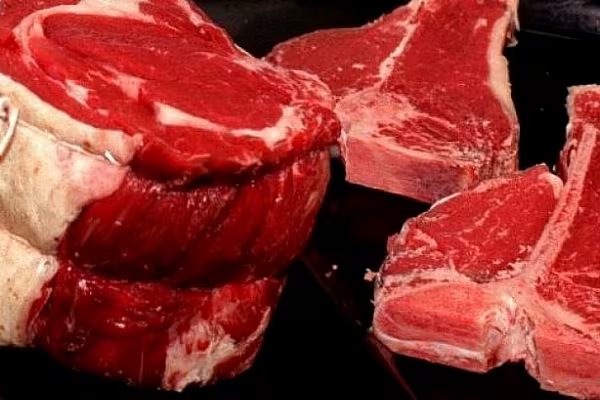The U.S. beef boom is probably over.
Thanks to tightening animal supplies and tepid demand, companies including Tyson Foods Inc., the largest U.S. meat processor, and Cargill Inc. are facing plunging profits on every head of cattle they slaughter.
That’s a sharp reversal of fortune from last year, when the fastest expansion of the American cattle herd in four decades increased margins for packers. But, the herd growth didn’t last long. As a result, cattle futures in Chicago have rebounded 23 percent since bottoming in mid-October, while the price packers get for wholesale beef has tumbled in the past year amid stiff competition from chicken and pork.
“It posts a pure squeeze on packer margins lower,” said Bob Wilson, a founding partner at industry researcher HedgersEdge.com LLC in Greenwood Village, Colorado.
Losses for U.S. beef packers expanded to $67.15 a head on Jan. 25, according to data from HedgersEdge.com. Profit per head reached an all-time peak of $147.20 on Oct. 18 and averaged $43.79 in 2016, the highest for any year in records going back to 1990.
Tyson Impact
The margin reversal may be a blow to Springdale, Arkansas-based Tyson. In fiscal 2016, its beef segment rebounded to an operating profit of $347 million from a loss of $66 million a year earlier, with former Chief Executive Officer Donnie Smith calling it “a great turnaround story,” according to a statement on Nov. 21. The company’s shares have jumped 22 percent in 12 months, closing at $62.63 on Wednesday. They traded at $62.06 at 11:26 a.m. on Thursday.
But, it doesn’t look like the beef turnaround is certain to last.
Analysts have lowered their consensus one-year target price for Tyson’s stock by 1.1 percent in the last month, data compiled by Bloomberg show. Heather Jones, a Richmond, Virginia-based analyst for Vertical Group, cut her rating on the shares to hold from buy in a report on Wednesday, citing a “rough start” for beef this year.
Jones still raised her profit estimate for Tyson’s fiscal first quarter, which spanned October through December. She raised her outlook on earnings per share to $1.36 from $1.20, partly because of “strong” beef performance, though she is “somewhat more cautious” on the outlook for the segment’s margins for the subsequent three quarters. Tyson is scheduled to report fiscal first-quarter earnings on Feb. 6.
Tyson and Cargill declined to comment on their beef margins.
Tyson’s beef division is its largest by revenue -- $14.5 billion in the year ended Oct. 1 -- but the smallest by profit. Still, the company has highlighted improvement from the business as a reason not to sell the unit. Tyson has a goal of pushing its adjusted earnings per share up as much as 10 percent in fiscal 2017.
Beef processors have endured painful times before. Tyson and Cargill closed slaughter plants in the last several years after drought and higher feed costs forced producers to cull the national cattle herd to the smallest since the 1950s. Things started to improve as cheaper corn and better weather allowed for expansion over the last two years. A bigger U.S. cattle herd helps improve plant utilization, and processors were able to spread their costs across a greater number of animals. Demand for beef products also climbed domestically and internationally.
Beef Margins
Tyson in November forecast beef-segment margins for fiscal 2017 would be at the upper end or above the normalized level of 1.5 percent to 3 percent. In the prior year, the margins were 2.4 percent.
Now, that goal is looking tougher based on the trend at U.S. feedlots, where 750-pound steer are placed on a corn-based diet for about five months and then sold at 1,300 pounds for slaughter.
The number of animals held on feedlots probably fell 1 percent in December, according to a Bloomberg survey of 11 analysts. The government is scheduled to release a report on the figures on Friday. The recent gains for cattle prices reflect the “increasingly tight supplies of market-ready fed” animals, Wilson of HedgersEdge.com said
At the same time, weak growth for U.S. beef demand has lowered the prices for which Tyson and other companies can sell their meat. Consumers have moved away from red meat amid health concerns, while booming supplies of chicken and pork have also made the alternative proteins more competitive.
Per capita U.S. beef consumption will be 56.6 pounds in 2017, down from a high of 94.3 in 1976, government data going back to 1960 compiled by the National Chicken Council show. The trend for chicken has been almost the mirror opposite, with per capita consumption expected to reach 90.4 pounds this year, more than double what it was four decades ago, according to the NCC website.
Beef Demand
“When you have more meat available, unless you’ve got strong growth in demand, that product is going to be consumed at a lower price,” said John Nalivka, the president of Sterling Marketing Inc., an industry consulting firm in Vale, Oregon. “People simply do not eat as much beef as they used to.”
As lower wholesale-beef prices crimp profits for packers, consumers aren’t seeing all the savings. The spread between wholesale and retail prices was $2.63 a pound in December compared with $1.62 in December 2005.
“While retail prices have been trending down, the decline is far slower than the fall in wholesale prices, allowing retailers to earn hefty margin on beef,” Farha Aslam, a New York-based analyst for Stephens Inc., said in a report on Jan. 24.
News by Bloomberg, edited by ESM. Click subscribe to sign up to ESM: The European Supermarket Magazine.














